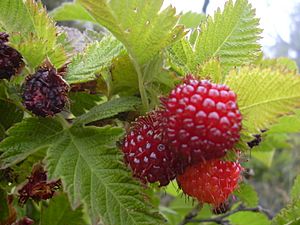Rubus hawaiensis facts for kids
Quick facts for kids Rubus hawaiensis |
|
|---|---|
 |
|
| Scientific classification | |
| Genus: |
Rubus
|
| Species: |
hawaiensis
|
| Synonyms | |
|
|
The Rubus hawaiensis, also known as the ʻĀkala, is a special type of raspberry. It is one of two kinds of Hawaiian raspberries that grow only in Hawaii. This plant is endemic to Hawaii, which means it naturally lives there and nowhere else in the world.
You can find the ʻĀkala on several Hawaiian islands. These include Kauaʻi, Molokaʻi, Maui, O'ahu, and Hawaiʻi. It grows in forests that are either moderately wet or very wet. These forests are found at high elevations, from about 600 to 3,070 meters (2,000 to 10,000 feet) above sea level.
In most places, the ʻĀkala is not very common. But in some areas, like parts of Haleakalā and the Laupāhoehoe Natural Area Reserve, it grows a lot. It can even be a main plant growing under the taller trees. Even though it looks a bit like another Hawaiian raspberry, Rubus macraei, scientists believe they came to Hawaii separately.
Contents
What Does the 'Ākala Look Like?
The Rubus hawaiensis is a deciduous shrub. This means it is a woody plant that loses its leaves every year. It usually grows in a clump, with stems that stand up straight. When the stems get longer, they might arch over. These stems can grow to be about 1.5 to 3 meters (5 to 10 feet) long.
Its leaves are made up of three smaller leaflets. The fruit of the ʻĀkala is red and quite large. It can be up to 4 centimeters (1.6 inches) long and 2.5 centimeters (1 inch) wide. While you can eat the fruit, people do not often eat it. This is because it tastes sour and a bit bitter.
Does the 'Ākala Have Thorns?
Many people describe the ʻĀkala as being "thornless." It is often used as an example of how plants on islands might lose their defenses. However, most young ʻĀkala plants do have thin prickles. These prickles are like small, sharp points.
As the plant's stem grows, its outer layer of bark usually peels off. When this happens, the prickles often fall off with the bark. So, older stems might appear smooth and without prickles.
Protecting Native Hawaiian Plants
People have been interested in growing raspberries without prickles. This has led to new types of Rubus plants being brought to Hawaii from other parts of the world. Some of these new plants have escaped from gardens and farms. They have become a problem because they grow very quickly and spread widely.
These new plants are called invasive species. They can take over areas where native Hawaiian plants, like the ʻĀkala, usually grow. Examples of these invasive plants include the yellow Himalayan raspberry and the Florida prickly blackberry.
The presence of these invasive Rubus species, along with the two native Hawaiian species, has led to important discussions. People are trying to figure out the best way to protect Hawaii's unique ecosystems. They want to control the invasive plants without harming the native ones. This is a big challenge for scientists and conservationists.
Images for kids
See also
 In Spanish: Frambuesa hawaiana para niños
In Spanish: Frambuesa hawaiana para niños


